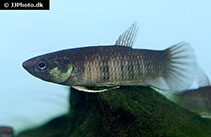| Diagnosis: |
Dorsal spines (total): 1-1; Dorsal soft rays (total): 8-8; Anal spines: 2-2; Anal soft rays: 24-24. Differs from B. enisae by: the absence of caudal transverse bars versus presence; more anal rays (25-27, mode 27, versus 23-26, mode 24-25); more subdorsal scales (5 1/2-7, mode 7, versus 5); more lateral scales (28-30, mode 30, versus 26-28, mode 27); smaller predorsal length (62.1-67% SL, versus 67.3-70.3); larger body depth at dorsal-fin origin (28.7-32.8% SL, versus 26.2-28.9); slightly longer pelvic fin (33.9-55.4% SL, versus 33.8-46.7); longer dorsal-fin base (11.4-14.9% SL, versus 8.7-12.1); smaller total length (12.8-15.1% SL, versus 14.3-15.5); smaller orbit diameter (48-69% of postorbital length, versus 57-68); smaller interorbital width (64-74% of postorbital length, versus 70-76) (Ref. 30224). Can be further differentiated from its congeners by: the absence of chin-bar (versus presence in B. pugnax, B. prima and B. pulchra); presence of dark distal borders on anal and caudal fins (versus absence in B. pugnax, B. fusca, B. schalleri, B. prima and B. pulchra; absence of caudal transverse bars (versus presence in B. pugnax and B. pulchra; more anal rays than B. fusca (25-27, versus 24-25); fewer lateral scales than B. schalleri (28-30, versus 31); more predorsal scales than B. schalleri (19-21, mode 21, versus 17-19, mode 19); more postdorsal scales than B. prima (11-12, versus 9-10); greater head length than B. fusca (51.3-54.3% predorsal length, versus 47.2-49.4); smaller predorsal length than B. fusca and B. prima (62.1-67% SL, versus 68.1-70.2); smaller postdorsal length than B. prima (21.9-23.4% SL, versus 24.1-26.3); smaller preanal length than B. prima (48-51.5% SL, versus 50.6-54.8); greater body depth than B. schalleri (28.7-32.8% SL, versus 26.7-27.6); longer pelvic fins than B pugnax (filamentous tip reaching 9-18th anal ray, versus 4-10th; 33.9-55.4% SL, versus 26.6-43.8); longer anal-fin base than B. fusca and B. schalleri (51.1-54.5% SL, versus 47.8-52); smaller orbit diameter than B. pugnax and B. pulchra (24.2-28.5% HL, versus 27.9-38.5); smaller interorbital width than B. pugnax and B. pulchra (29.6-36.1% HL, versus 32.4-53) (Ref. 30224). |

